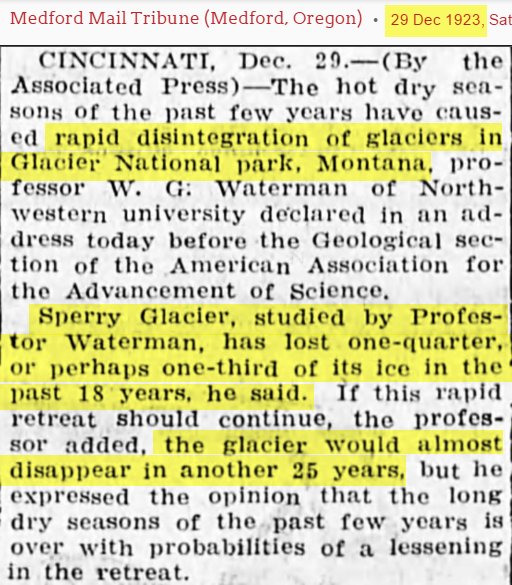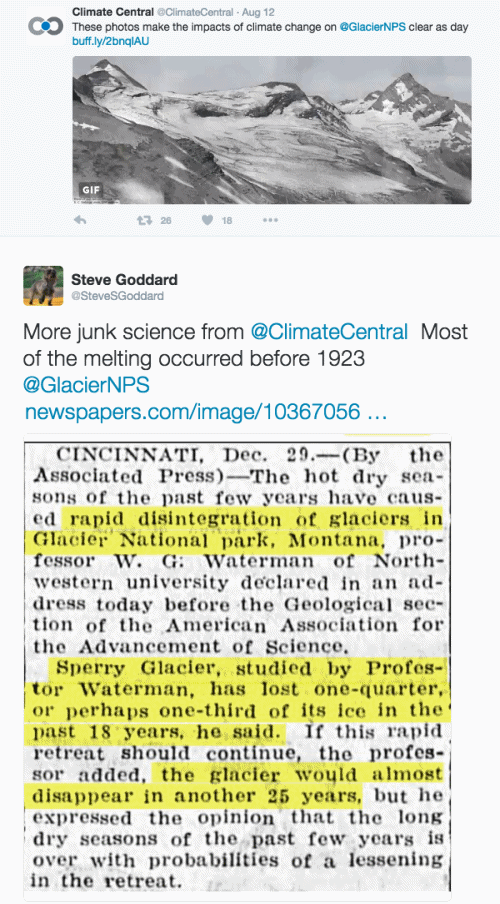2012 paper finds glaciers in Glacier National Park retreated up to 6 times faster during the 1930’s than the past 40 years — Paper published in Quaternary Science Reviews
https://hockeyschtick.blogspot.com/2012/09/new-paper-finds-glaciers-in-glacier.html
A new paper published in Quaternary Science Reviews finds that alpine glaciers in Glacier National Park, Montana retreated up to 6 times faster during the 1930’s and 1940’s than over the past 40 years. The “Multi-proxy study of sediment cores retrieved from lakes below modern glaciers supports the first detailed Neoglacial chronology for Glacier National Park (GNP)” and shows “maximum reconstructed retreat rates [in] 1930” of about 125 meters per year, compared to near zero in ~1975 and about 20 meters/year at the end of the record in ~2005. The authors report, “Results indicate that alpine glaciers in Glacier National Park advanced and retreated numerous times during the Holocene after the onset of Neoglaciation 6,500 years before the present” and “Retreat from the Little Ice Age maximum was the most dramatic episode of ice retreat in at least the last 1000 years.”
| Fig. 8. Relationship between climate, retreat of the Agassiz Glacier, and flux of carbonate in core UKL-1 from AD 1750 to the present. Dashed line shows CaCO3 flux in mg/cm2/yr. Filled gray line illustrates the reconstructed retreat rate of the Agassiz Glacier from its LIA terminal moraine, calculated from dating of trees in the glacier forefield (Carrara and McGimsey, 1981). Carbonate flux began to rise at the onset of ice retreat, and reached a peak nearly synchronous with the maximum reconstructed retreat rates ca AD 1930. Filled black line presents a tree-ring compilation (BMS Douglas Fir) sensitive to summer drought collected in the vicinity of the Agassiz Glacier (Pederson et al., 2004). Black fill (note reversed scale) denotes wetter, cooler conditions that were responsible for advance of the Agassiz Glacier to its LIA maximum position. Retreat began with the switch to below-normal precipitation. |
A lacustrine-based Neoglacial record for Glacier National Park, Montana, USA
- Jeffrey S. Munroea,
,
,
- Thomas A. Crockera,
- Alena M. Gieschea,
- Lukas E. Rahlsona,
- Logan T. Durana,
- Matthew F. Bigla,
- Benjamin J.C. Laabsb
- a Geology Department, Middlebury College, 276 Bicentennial Way, Middlebury, VT 05753, USA
- b Department of Geological Sciences, SUNY Geneseo, Geneseo, NY 14454, USA
Abstract
Highlights
33% of Glacier National Parks Ice melted during the coldest years on the Montana Stripe Graph. Glacial Ice was supposed to be totally gone from GNP by 1948. 72 years later, guess what? They still have Glaciers.
Remember, always listen to the experts without question. pic.twitter.com/2ujmkcq1fb
— JR4Truth (@JR4_Truth) June 18, 2020
If 33% melted by 1923 during 18 of the Coldest years on record why didn't the rest melt since then and during the last 35 super hot years?
— JR4Truth (@JR4_Truth) June 18, 2020
Grinnell Glacier: 1,020,200.39 square meters in 1966; 563,720.29 m2 in 2015; Data. Images. Facts. Science. 2/x pic.twitter.com/CSluhKvgUv
— @borenbears (@borenbears) June 18, 2020
Blackfoot glacier 1966: 1,832,451.35 m2; 2015: 1,498,505.92 m2; Jackson glacier 1966: 1,280,508.24 m2; 2015: 756,864.10 m2; Data. Science. Reality. 3/x pic.twitter.com/vW7XZluqza
— @borenbears (@borenbears) June 18, 2020
Yes, we're in an interglacial phase, we should expect some of this activity. Though that doesn't address the point, why was there so much loss during the "coolest" years on record but less loss when it's supposedly been much warmer?
— JR4Truth (@JR4_Truth) June 18, 2020
You are picking just one of the more than 30 glaciers, Sperry, and comments from a single scientist 97 years ago, really? What a strawman argument. It's because globe has warmed 1 dC since 1880. Glacier National Park glaciers have decreased 68.29% since 1850. Data. Reality. Bye. pic.twitter.com/uzIQXDQIHO
— @borenbears (@borenbears) June 18, 2020
There's more to the story: 2012 paper finds glaciers in Glacier National Park retreated up to 6 times faster during the 1930’s than the past 40 years — Paper published in Quaternary Science Reviewshttps://t.co/e0pUTlinMd
— Marc Morano (@ClimateDepot) June 18, 2020
"Results indicate that alpine glaciers in Glacier National Park advanced & retreated numerous times during the Holocene after the onset of Neoglaciation 6,500 years before the present'…"
— Marc Morano (@ClimateDepot) June 18, 2020
"and 'Retreat from the Little Ice Age maximum was the most dramatic episode of ice retreat in at least the last 1000 years."
— Marc Morano (@ClimateDepot) June 18, 2020
#
Background material:
Flashback 1923: Experts said Glacier National Park would be ice-free by 1950 – In 1923, experts said Glacier National Park would be ice-free by 1950. http://realclimatescience.com/2016/08/bernie-says-the-national-parks-are-about-to-be-swallowed-by-climate-change/ …


New paper finds glaciers in Glacier National Park retreated up to 6 times faster during the 1930’s than the past 40 years — Paper published in Quaternary Science Reviews – ‘Results indicate that alpine glaciers in Glacier National Park advanced and retreated numerous times during the Holocene after the onset of Neoglaciation 6,500 years before the present’ and ‘Retreat from the Little Ice Age maximum was the most dramatic episode of ice retreat in at least the last 1000 years.’
National Parks Quietly Toss Signs Saying Glaciers ‘Will Be Gone’ By 2020 (They’re Growing)
Climate alarmists meltdown over Glacier Nationlal Park
Greenland’s Glacier Grows Alarming Climate Hysterics – A screaming lack of enthusiastic media coverage regarding recent evidence that Jakobshavn, the previously fastest-flowing, fastest-thinning glacier on Greenland’s west coast, has now gone rogue. Jakobshavn has represented the largest source of periodic ice mass loss over the last 20 years, and has produced about 10 percent of the country’s icebergs.
A study published last month in the journal Nature reported, “Here we use airborne altimetry and satellite imagery to show that since 2016, Jakobshavn has been re-advancing, slowing and thickening. We link these changes to current cooling in ocean waters in Disko Bay that spill over into Ilulissat Icefjord. Ocean temperatures in the bay’s upper 250 meters have cooled to levels not seen since the mid-1980s.”
GLACIERS
Some glaciers melted faster before 2nd half of 20th century — Leading Arctic Researcher Shows That Glacial Melt Slowed Substantially Since 1952 — ‘Leading Arctic expert William Carlson said that glaciers in Norway & Alaska lost half their size during the fifty years before 1952. Had that rate of loss continued, there would have been no glaciers left in Alaska or Norway by 2002. Given that there are glaciers remaining, we can infer that the rate of ice loss was slower in 2nd half of century than it was in 1st half of century’
UN Report: ‘Glaciers increasing despite climate change’ — ‘Glaciers in many parts of the world are increasing’ — ‘Glaciers have grown in western Norway, New Zealand’s South Island, parts of Asia and the Tierra del Fuego in South America.’
UN IPCC Wrong: Himalayan glaciers not melting because of climate change, report finds: ‘Himalayan glaciers are actually advancing rather than retreating, claims the first major study since a controversial UN report said they would be melted within quarter of a century’
IPCC Caught Again! ‘Importance Of Glaciers As A Source Of Fresh Water Exaggerated, Say Austrian Scientists: ‘IPCC has also grossly exaggerated the importance of glaciers as a source of fresh water…It is an exaggeration when it is claimed that the melting of glaciers endangers the water supply of 2 billion people.’



